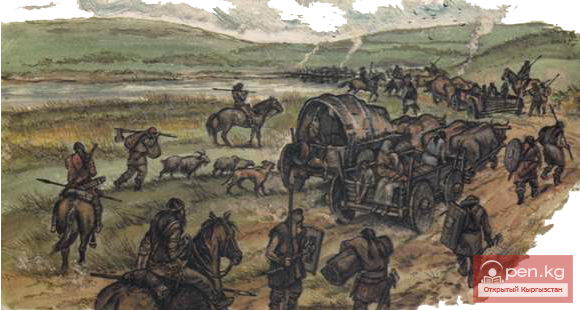
Ethnic Self-Consciousness of the Kyrgyz People In 1517, the ruler of the Kyrgyz was Muhammad....

Disputes about the origin of the Kyrgyz are still relevant Among the variety of data available in...

Gyan-gun and Dinlins In the sources of the 1st-2nd centuries AD, the gyan-gun are not mentioned,...

Ethnic Situation in the Tian Shan in the Middle Ages A comparative analysis of sources and early...

Legends. In the first half of the 12th century, it is likely that the "Karakhanid"...

Ibrahim ibn Ahmed and Anal-Hakk Thus, the "progenitor" of the Kyrgyz ethnicity of the...

Ethnic Processes in Southern Siberia in the IX-XII Centuries After the defeat of the Uyghur...

Kyrgyz-Gyangu The earliest mention of the Kyrgyz under the Chinese name “gyan-gun”, “heguni”, or...

Ethnocultural Connections Between the Kyrgyz and the Kipchaks The significance and political role...

Ancient People — Kyrgyz The Kyrgyz, whose roots go deep into antiquity, lost in the darkness of...

Key Milestones in the Ethnogenesis of the Kyrgyz People An important stage in the study of the...

The ethnonyms “Turk” and “Turkut” were first mentioned in a Chinese chronicle from the year 546....

The Flourishing of Medieval Kyrgyz Culture The era of "Kyrgyz Great Power" became a time...

Formation of the Kyrgyz People The Kyrgyz people were formed on the basis of two ethnic masses:...

How did the Kyrgyz appear in Tian Shan? A special place in the study of the monuments of oral folk...

Movement of the Altai Kyrgyz to the Western Regions of Mogolistan In the study of the...

For a proper understanding of the ethnic processes that led to the formation of the Kyrgyz...

Versions on the Origin of the Central Asian Component of the Kyrgyz Ethnos A more substantiated...

The Karakhanid Kingdom...

Kyrgyz in Uzbekistan Beyond Kyrgyzstan, Kyrgyz people have long lived in China and Uzbekistan,...

The Karakhanid period, as the apex of Turkic civilization, was a time when science and education...

Kyrgyz Great Power During the VI-VIII centuries, when the Kyrgyz state existed only in the...

All political entities of the Middle Ages in the territory of Central Asia somehow affected the...

Kyrgyz Division into Tribes and Clans Despite the absence of a centralized state, the Kyrgyz had...

History of the Origin of the Kyrgyz People The problem of the origin of the Kyrgyz people is one...

The Infiltration of Yenisei Kyrgyz into the Tian Shan Our task is to examine the issues regarding...

History of the Chagatai Ulus (13th century), the state formations of Haidu (13th—14th centuries),...

Today, October 30, the Vice Prime Minister of the Kyrgyz Republic Elvira Sarieva participated in...

Ulus Inga-Tyuri During military clashes, it appears that part of the "Central Asian"...

Discussion Problems on the Origin of the Kyrgyz People In recent years, professional historians...

The Saka tribes were divided into three parts. In the southern regions of Kyrgyzstan lived the...

Ichkiliki and Arkalyki. The name "Ichkiliki" may have originated from the ancient Turkic...

A. G. Malyavkin. Historical Geography of Central Asia. Novosibirsk, 1981 "Jiu Tanshu"...

The Conquest of the Kyrgyz by Russia. In the last quarter of the 18th century, the southern tribes...

Kyrgyz K. A. Pishulina rightly points out that only those tribes and clans that participated in...

The Influence of Islam on Kyrgyz Rituals On the map of the Liao era (916—1125) and Northern Song...

The Defiance and Bravery of the Kyrgyz The ambitions of the Qing dynasty and their aggressive...

According to the genealogy (shézhere) preserved from the time of our ancestors, the progenitor of...

Basic Information about the Kyrgyz Language The Kyrgyz language is the state language of the...

Muhammad Haider refers to the Kyrgyz as "the forest (wild) lions of Moghulistan." It is...

Karluks...

Facts Supporting the Statement of Prominent Soviet Ethnographer and Kyrgyz Scholar S. M. Abramzon...

THE ORIGIN OF THE KYRGYZ This happened deep in Central Asia many, many years ago. Fierce...

Arkanuts, Arlats, Barlasses The problem being studied is one of the complex and poorly researched...

The next territory of interest in terms of historical and genealogical connections with Kyrgyz...